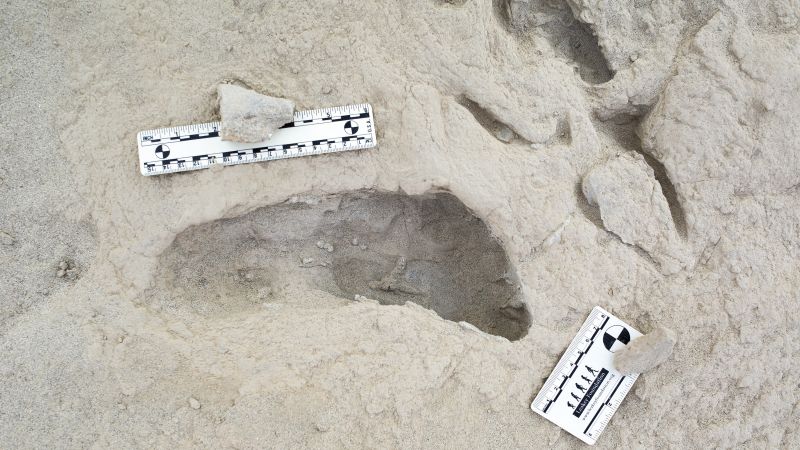In a groundbreaking study published in the esteemed journal *Science*, researchers revealed an extraordinary find that dates back over 1.5 million years. The discovery, which occurred along a lakeshore at Koobi Fora on the eastern shore of Lake Turkana, Kenya, centers around fossilized footprints left by two distinct species of ancient human ancestors, or hominins. This rare evidence suggests that these early human relatives, possibly Homo erectus and Paranthropus boisei, cohabitated the same environment, shedding light on the interactions of early human species.
The significance of these findings is bolstered by the landscape of the time, which was populated with diverse wildlife, including massive marabou storks that stood about six and a half feet tall. Evidence from the footprints indicates that these hominins were not mere neighbors in a competitive struggle for resources; rather, they may have shared this lakeside habitat, perhaps even interacting with each other. Kevin Hatala, an associate professor of biology at Chatham University and the study’s lead author, noted the surprising nature of having similarly sized large-bodied hominin species coexisting in proximity. Hatala expressed that the prints suggest these species passed through the same area within hours to days of each other, indicating a shared but dynamic environment.
The initial discovery stemmed from an excavation in July 2021, where researchers uncovered a single hominin footprint alongside avian tracks. Following this, additional digs occurred in 2022, where an expansive area of sediment revealed not only the original footprint but also multiple tracks believed to be made by the same individual. The meticulous excavation work uncovered a trove of data, such as 11 hominin tracks and a variety of tracks from birds and large mammal-like creatures, demonstrating the high biodiversity of the ecosystem at the time.
Hatala described the trackway as a collection of footprints made at a decent pace in a “perfect zone of mud,” emphasizing the unique conditions that allowed for such precise preservation. This zone closely resembles modern-day beach environments where certain conditions prevent footprints from being disturbed or eroded. The tracks were mostly smoothly preserved, showcasing the rapid natural burial by fine silty sands shortly after they were made. These tracks have become the first physical evidence supporting the notion that distinct hominin species occupied the same geographical location concurrently.
Despite the inability to directly date the footprints, contextual evidence suggests they were slightly older than volcanic ash deposits in the area, pinpointing their formation to around 1.52 million years ago. The absence of cracking on the surface of the tracks strongly implies they were made within a brief window, lending credibility to the timeline.
Additionally, Hatala and his research team identified that while the two hominin species, known as Homo erectus and Paranthropus boisei, seemed to coexist, they likely exhibited different traits and dietary preferences. The larger Homo erectus was likely an omnivore, in contrast to Paranthropus boisei, which had physical adaptations indicative of a plant-based diet. Evidence suggests these two species may have shared a habitat for an extended period, possibly up to 100,000 years. This cohabitation raises intriguing questions about how these species interacted — whether they competed directly for resources or perhaps avoided each other altogether.
The implications of this discovery extend beyond mere coexistence; they suggest a complex weave of interactions among early human relatives at a time when the landscape was fraught with potential dangers from predators such as hippos and crocodiles. The research is ushering in a new chapter in the understanding of human evolution, indicating that life for these ancient relatives was not solely about survival in competition, but also encompassed elements of coexistence, interaction, and adaptation.
Renowned paleontologist Briana Pobiner, whose work with the Smithsonian’s Human Origins Program explores similar areas of research, highlights the remarkable nature of these findings. She remarks on the potential interactions between the species, pondering whether they actively competed for resources or coexisted more passively.
This evidence adds to the growing body of knowledge concerning human evolution, showing direct interactions between different hominin species, similar to the genetic interbreeding documented between Homo sapiens and Neanderthals. The study evokes expansive possibilities, suggesting that Homo erectus and Paranthropus boisei may have even shared genetic material.
The coexistence of these ancient species paints a fascinating picture of our evolutionary history, where diverse adaptations and survival strategies shaped the landscape of human ancestry. With this finding, researchers are not merely identifying ancient paths trod by our predecessors; they are uncovering the intricate social and ecological webs that existed in the formative years of human evolution. The physical footprints in the mud become more than mere impressions; they serve as a potent reminder of the complex narratives woven into our shared heritage.



